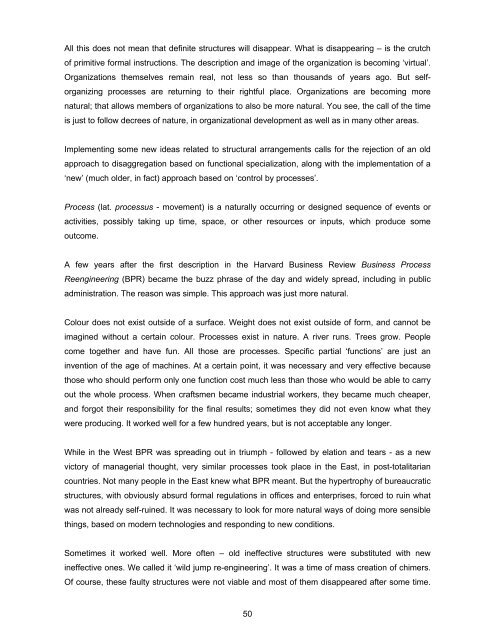Organizational Development: A Manual for Managers and ... - FPDL
Organizational Development: A Manual for Managers and ... - FPDL
Organizational Development: A Manual for Managers and ... - FPDL
Create successful ePaper yourself
Turn your PDF publications into a flip-book with our unique Google optimized e-Paper software.
All this does not mean that definite structures will disappear. What is disappearing – is the crutch<br />
of primitive <strong>for</strong>mal instructions. The description <strong>and</strong> image of the organization is becoming ‘virtual’.<br />
Organizations themselves remain real, not less so than thous<strong>and</strong>s of years ago. But sel<strong>for</strong>ganizing<br />
processes are returning to their rightful place. Organizations are becoming more<br />
natural; that allows members of organizations to also be more natural. You see, the call of the time<br />
is just to follow decrees of nature, in organizational development as well as in many other areas.<br />
Implementing some new ideas related to structural arrangements calls <strong>for</strong> the rejection of an old<br />
approach to disaggregation based on functional specialization, along with the implementation of a<br />
‘new’ (much older, in fact) approach based on ‘control by processes’.<br />
Process (lat. processus - movement) is a naturally occurring or designed sequence of events or<br />
activities, possibly taking up time, space, or other resources or inputs, which produce some<br />
outcome.<br />
A few years after the first description in the Harvard Business Review Business Process<br />
Reengineering (BPR) became the buzz phrase of the day <strong>and</strong> widely spread, including in public<br />
administration. The reason was simple. This approach was just more natural.<br />
Colour does not exist outside of a surface. Weight does not exist outside of <strong>for</strong>m, <strong>and</strong> cannot be<br />
imagined without a certain colour. Processes exist in nature. A river runs. Trees grow. People<br />
come together <strong>and</strong> have fun. All those are processes. Specific partial ‘functions’ are just an<br />
invention of the age of machines. At a certain point, it was necessary <strong>and</strong> very effective because<br />
those who should per<strong>for</strong>m only one function cost much less than those who would be able to carry<br />
out the whole process. When craftsmen became industrial workers, they became much cheaper,<br />
<strong>and</strong> <strong>for</strong>got their responsibility <strong>for</strong> the final results; sometimes they did not even know what they<br />
were producing. It worked well <strong>for</strong> a few hundred years, but is not acceptable any longer.<br />
While in the West BPR was spreading out in triumph - followed by elation <strong>and</strong> tears - as a new<br />
victory of managerial thought, very similar processes took place in the East, in post-totalitarian<br />
countries. Not many people in the East knew what BPR meant. But the hypertrophy of bureaucratic<br />
structures, with obviously absurd <strong>for</strong>mal regulations in offices <strong>and</strong> enterprises, <strong>for</strong>ced to ruin what<br />
was not already self-ruined. It was necessary to look <strong>for</strong> more natural ways of doing more sensible<br />
things, based on modern technologies <strong>and</strong> responding to new conditions.<br />
Sometimes it worked well. More often – old ineffective structures were substituted with new<br />
ineffective ones. We called it ‘wild jump re-engineering’. It was a time of mass creation of chimers.<br />
Of course, these faulty structures were not viable <strong>and</strong> most of them disappeared after some time.<br />
50
















